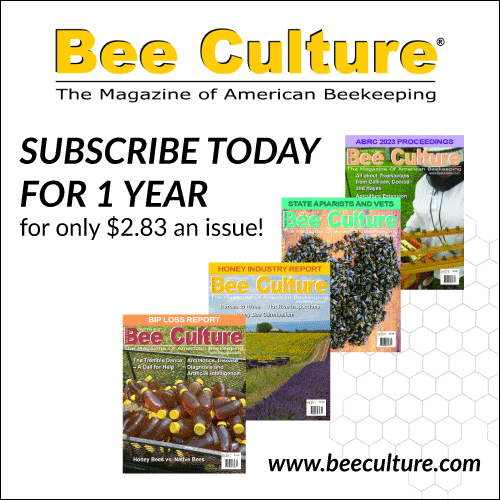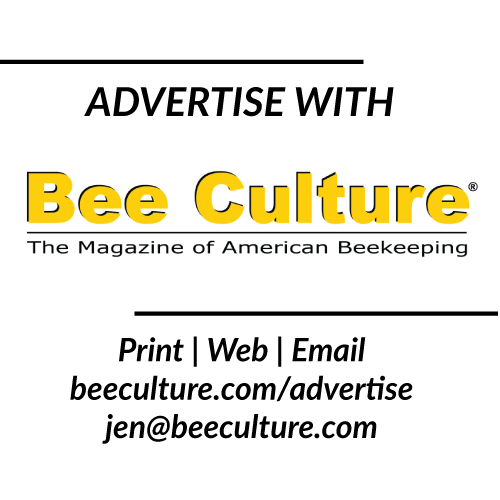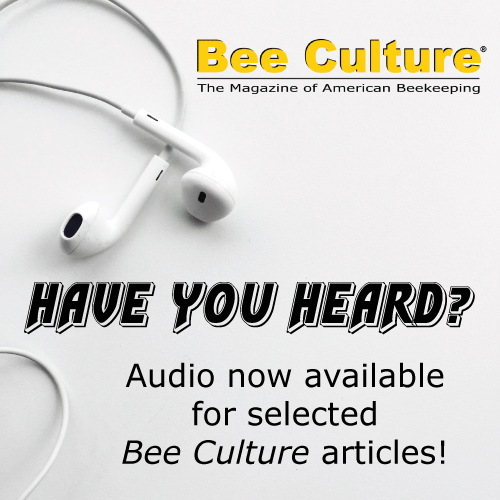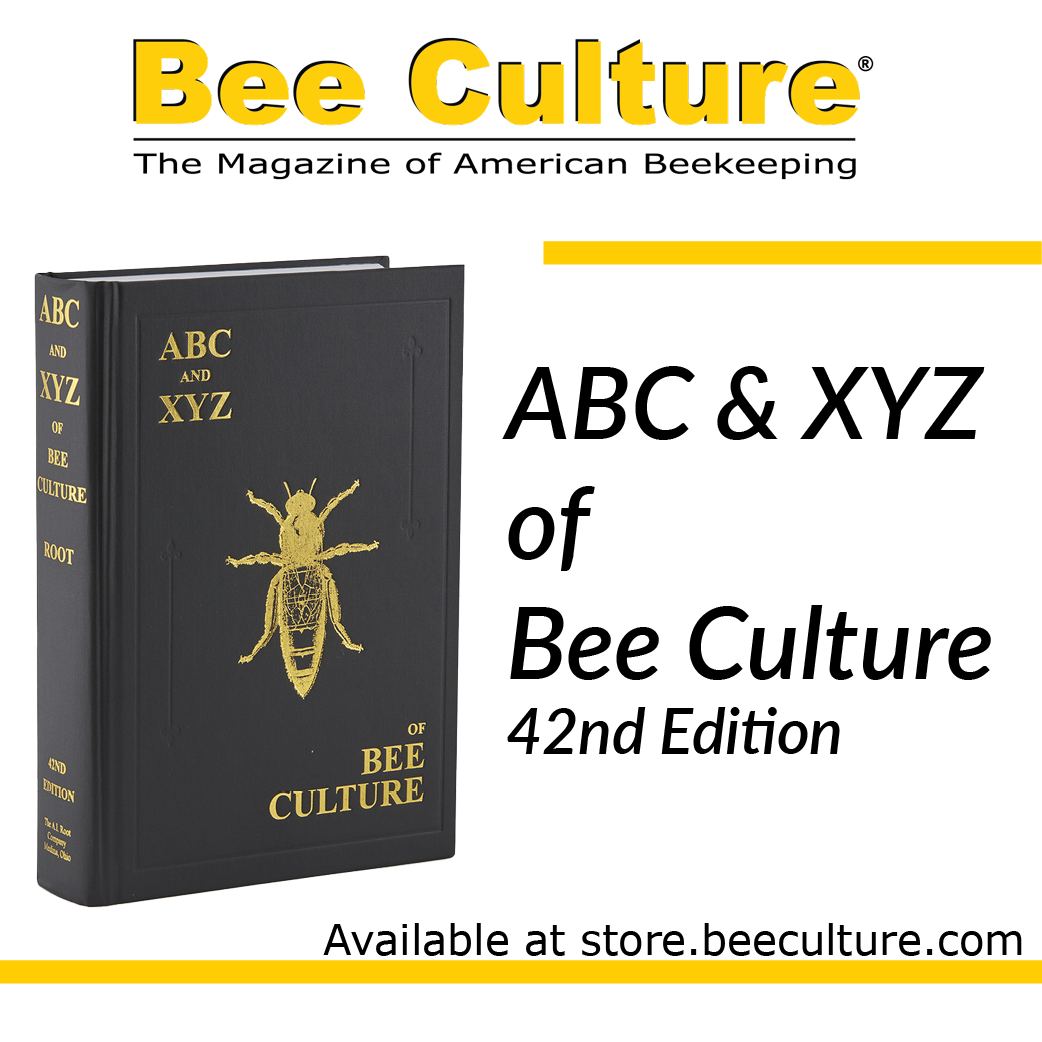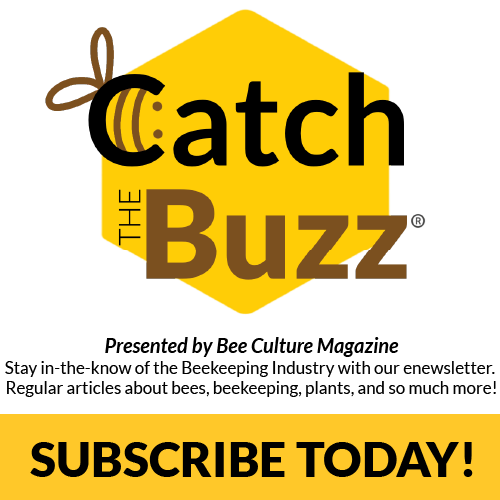Click Here if you listened. We’d love to know what you think. There is even a spot for feedback!
Read along below!
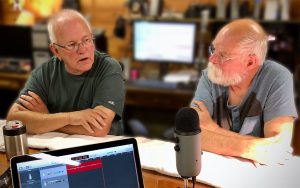
James E. Tew & Kim Flottum. Photo Credit: Honey Bee Obscura podcast (https://www.honeybeeobscura.com/)
A Conversation with Kim Flottum, Part 1
Retired, Longtime Bee Culture Magazine Editor
By: James E. Tew
We’ve grown old together
Readers, I’ve been friends and have worked with Kim Flottum, former Bee Culture editor for nearly forty years. He began his responsibilities at Bee Culture Magazine in 1986. I was still a kid of 38 when Kim took the job in Medina, Ohio. Over the many ensuing years, for better or worse, Kim accepted more than 300 of my articles. We attended innumerable bee meetings and we produced electronic projects. We put together slide-deck programs and now, with the help of Jeff Ott, Kim and I present podcasts on various topics every week. I could not think of anyone more appropriate for an in-depth conversation. Ours has been a long, long trek. What follows is Kim’s view of that historical pathway.
Kim: I grew up in Central Wisconsin in the 1950’s. I played some high school football and I worked in a grocery store. I had a good childhood with many memories. College became an option so I attended the University of Wisconsin-Eau Claire for a while and then I transferred to the University of Wisconsin at Madison where I studied horticulture and entomology. I landed a contract job working for an entomologist there. After a few years, the funding for that assistant position ran out and I had to find another job. The USDA Agricultural Research Service, Honey Bee Research Lab headed by Dr. Eric Erickson was on the fourth floor of the building where I had been working.
Dr. Erickson and I were talking in the break room one day, and he said, “Do you know anybody that can do this, this, and this?” I said, “Yes – me.” He said, “Well I need somebody that can grow soybeans, and look at pollination, and look at bees and work bees,” and do all this crazy stuff. “Yes, me.” I needed a job, he needed an employee, so I just moved two floors up and I was there for four years. Go figure.
Jim: Were you going to school all this time? Were you taking other classes?
Kim: Yes, I graduated before I finished working for Eric. I worked for Erickson for four years, doing things I would’ve never imagined doing, and at the end of four years I was funded by a grant. I was totally supported by that grant; Eric needed a grad student.
At the end of four years the grant ended, and Dr. Erickson said, “Well folks we’re packing up. We’re moving the lab to Arizona. Been fun working here, bye.” “Well okay.” I moved to Connecticut, where I knew some people, and I got a job working in a greenhouse, and then I got a job working on a farm. I was raising a couple hundred acres of vegetables, and fruit, and the like. I had apple orchards and sweet corn – all sorts of things.
While I was there, I decided to get involved with the Connecticut State Beekeepers Association. Suddenly I was a Connecticut beekeeper, and I went to my first bee meeting. Soon thereafter, the group needed a president, and I took on the job.
Jim: My goodness – that was fast.
Kim: They had taken the Penwalt Chemical Company to court, and they had won the case. Connecticut took the controversial pesticide Penncap-M off the market. Legal fees, for the court case, were $40,000. I was the president of the beekeeping group, and if you know how a business is run, the president ultimately is responsible for the bill unless there’s something set up to protect him. I turned around and there was nobody there to protect me.
For about a year I campaigned across New England, from Maine to Florida, and to Illinois, telling our story. “We got Penncap-M off the market, you can, too. Here’s how you do it. Form a coalition, pay one lawyer.” In less than a year, I raised the $40,000.
When I was the president of Connecticut Beekeepers, the president is also the EAS (Eastern Apiculture Society) delegate. Suddenly I was on the board of EAS, I went to the first EAS meeting and John Root, from Bee Culture, was there. He was on the EAS board, too. I had never even seen the magazine Bee Culture. I didn’t know about The A.I. Root Company. I had never bought a piece of beekeeping equipment in my life.
We got to talking a little bit, and he said, “I’ll send you a copy of our magazine.” He sent me a magazine, and I looked at it. I talked to bee people in Connecticut. As far as they were concerned, this magazine was the cream of the crop in beekeeping literature. The next time I went back to an EAS board meeting, John said, “What’d you think of the magazine?” I said, “I can see some things that I would probably alter a little bit, maybe change, whatever, but it’s got good information and it’s got good people reading it and writing for it.”
He said, “How’d you like to run it?” I said, “Let me think about that.” Three months later I took the job, and I moved to Ohio. Here I am, all these years later.
Jim: That’s a lot of information in a hurry, Kim. Good heavens. I thought that you worked for Erickson for four years.
Kim: I did.
Jim: During that time, you didn’t buy bee equipment or get involved with the equipment?
Kim: I didn’t have to. I was living in an apartment in downtown Madison, Wisconsin and I went to work every day and there were 300 or 400 beehives right in the middle of the city of Madison on a university experimental farm. I had all the bees I wanted, all the equipment I wanted, all the honey I wanted, I had everything I wanted. At the end of the day, I left it all there, and went home.
Jim: How did you learn beekeeping, from Erickson or from the staff there?
Kim: I had a guy named Dave Severson who was a graduate student in honey bee management. He taught me the craft. There was a guy there whose name I can’t remember at the moment, who did nothing his whole life except instrumentally inseminate queens. I learned that technique from him.
Then I had a guy there who could fix anything that could break – absolutely anything that could break. When I broke something, I took it to him, and he showed me how to fix it. Then I had another guy there who knew every plant that bees visited on every continent on earth.
I got to know a lot of the plant stuff on pollination and then we started planting pollinator gardens and we started looking at soil amendments for pollinator gardens and all the things that can affect a pollinator plant. We did that work for four years.
Another big project I accomplished was Penncap-M. It was still killing bees almost everywhere, but nobody had any really good numbers. For an entire Summer I owned a sweetcorn field, and I would be out there at 5:30 in the morning.
I had this specific path; it was a four-acre field, and I had this path walking through the cornfield. Every 40 feet or so, there was a stick in the ground. That was a plant that I looked at. How many bees are on this plant? What time was it? I did that all until the end of pollen shed. I did that for two years. By the end of two years, I could tell you how many bees would be on how many plants at what time of day. That caught a lot of attention. Then Eric had this thing about pollinating soybeans, and he said, “Can bees pollinate soybeans?” I said, “Why wouldn’t they?”
I found out why they would, and again, it was the same thing. It had to do with soil amendments, time of day, variety of soybean and the size of the bee population. We nailed that right down. The paper’s still out there. I’m still cited for that paper, believe it or not. We didn’t solve that problem, but we gave it a lot of ammunition. He said two things. He said, “This isn’t going to get me anywhere with USDA, but it’s been fun.” When I finished that corn experiment, that pretty much proved that spraying – What’s that chemical?
Jim: Penncap-M.
Kim: Yes, that’s it. Spraying Penncap-M at a certain time of day would kill every bee within 20 miles. If you waited three or four hours, it was all gone, and the bees visited and almost none of them died. The first talk I ever gave to a group of growers was how to use Penncap-M. I went in there with bulletproof armor on.
Jim: That was a gutsy move, Kim, though. Those were contentious times. Encapsulation was thought to be a safe way to use methyl parathion, encapsulated. It was driving bees crazy.
Kim: I gave a couple talks and nobody threw anything at me, interestingly. So, I was in Connecticut and participating in EAS, but I had to move to Ohio. I was here at Root, I don’t know, maybe an hour and a half and the Medina Beekeepers Association basically stole me and said, “You get to be on our board of directors.” Mark Bruner, the guy who had been editor before me, had gone to a couple of their meetings. I don’t know if you remember Larry Goltz, who was Bee Culture editor before Bruner.
Jim: I do.
Kim: Then there was Larry Goltz for 10 years before Bruner. For ten years, Larry Goltz edited the magazine.
Jim: How many editors have there been at Bee Culture?
Kim: I must give you a fuzzy answer because A.I. Root was the first one. Then it was A.I. and his son, and they were doing it together and then it was his son and his brother, and they were doing it together. Then they got a couple people who were working on the magazine just day-to-day on stuff and they’re all working together. Who’s the editor? There’s a name there, but there’s five names under it. I can say there’s been several, but many of them have been family.
Kim: Often it was the BC secretary who answered the phone. Often it was the lady who took the photographs and answered the phone. Sometimes it was the advertising manager who took the call. It wasn’t that there was somebody way up here, there was a whole bunch of people right in here. Depending on who it was, some of them would never take a call and some of them would take every call they could get.
Jim: This editorship history is overwhelming. All things considered up to this point, no doubt about it, you’re the longest serving editor.
Kim: Correct.
Jim: We can say that for sure. Then of course, after you, just to mention it in this article, Jerry Hayes is now the editor.
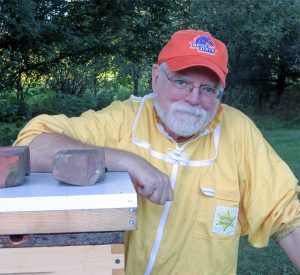
Figure 1. Peter Kim Flottum, former editor of Bee Culture beekeeping magazine and longtime friend.
Kim: All right, when all is said and done in Connecticut and John had hired me, I’d been to Medina to interview, he hired me, and he said, “Go.” We moved to Medina and rented an apartment for a little bit and then bought a house. The first day on the job, all the people at the work company came in and looked at me the way they do with new people. I didn’t know them, they didn’t know me, but it worked out all right.
I was in my chair, I don’t know, maybe a minute and a half, and the phone rang. It was one of the writers for the magazine that I didn’t know because I hadn’t read the magazine yet, who wanted to know when his article was due and thinking fast on my feet, I said, “The same day as last month.” He said, “Okay.” So, I got away with it. [laughter]
It took a while to get used to how the beekeeping industry and the Root Company interacted, and by then the Root Company was phasing way down in beekeeping supplies. They were still making some equipment, but production was headed in one downward direction. I took a look at that, and I took a look at the other manufacturers in the industry. I said, “Okay, I can see my future is not selling equipment from the Root Company. It is selling other people’s equipment to beekeepers.” That was the way I started.
When I moved there, the magazine didn’t have data at the time, the magazine didn’t have a person handling advertising. Somebody would call up and say, “I have an ad for the next month’s issue,” and the person who answered the phone says, “Okay, I’ll give the message to what’s her name and she’ll call you back.” That’s not service with a smile in my opinion. I hired a person to sell advertising due to people who were selling to beekeepers.
That turned out to be a very good choice to make because I got, “Oh, good.” I found a person who didn’t know anything about beekeeping, which was actually good because she had to ask what things were when an advertiser took something for granted. She didn’t know beekeeping specifics so she asked specific questions and it worked out well. We got advertising going and I took a look at the writers and the second big thing I did was do a reader survey.
Kim: We had about 9,000 subscribers at the time, and I picked out a third of them, 3,000. I put together a two-page survey of, “Who are you, how many bees, how long keeping bees, how old are you, where do you live, what do you like, what don’t you like? Reader survey.” I got replies back, and I took about a month to collate it. I found out that we were doing a lot of things that people couldn’t care less about, and we weren’t doing some things that people really wanted to know more about.
Once I gathered all the data and had some ideas of things to leave, things to change and things to get rid of, I summarized it for the writers. I told them, “These are the directions I think we should be going because this is what the readers want. Less here, more there, new here. Get rid of the old there.” The writers began to slowly change. Some, of course, would never change. Richard Taylor, a popular writer at the time, would never change, and I’m really glad he didn’t.
I’ll tell you a quick story about Richard Taylor. I went to his house several times because he lived in Ithaca, New York, where Roger Morris lived. Roger Morris, at Cornell, was my scientific stalwart in beekeeping information. He was the scientist that I had on call any time I wanted. I would go see Roger or some such trip, and then I would go to Richard’s.
I went to Richard’s house one day and he said, “You’re just in time. We’re going to go look at a beeyard.” I loaded into his model “T” Jeep, something really old, headed out to the beeyard, went down a highway, went down a dirt road, went down a track in the woods, went down so you could almost see through the trees, and came to the beeyard. It was out in the middle of absolutely nowhere.
There were about eight or nine colonies sitting in a semi-circle right in front of us, maybe 20 yards. He said, “Look at that yard.” He said, “I’ve died and gone to heaven.” This is where heaven is and he started to get out of the vehicle and he said, “Oh, look!” One of the colonies was starting to swarm and it was pouring out swarming bees. By the time he got close, the swarm was outside the hive and he did this – “I got the queen.” With his fingers, he pulled her right out of the air. Can you believe it?
Jim: Oh wow. He captured her out of the air?
Kim: I just sat there, and my mouth opened and I said, “How the hell do you do that?” He said, “Not most of the time.” [laughs]
Jim: Oh my.
Jim: As the years have passed, you have grown to look like Richard Taylor more and more.
Kim: Kind of, yes. Anyway, I got two, and then after four or five issues, maybe six issues had been out. I started in March. My first issue was May 1986.
Jim: So, your introductory period was March to May of ‘86.
Kim: By then, people were calling me up, “We’ve got a meeting coming up, would you like to speak?” My first thought was, “What do I speak about? I don’t know anything.” I knew research from the USDA bee lab, I could draw on that. I also had good information from the reader’s survey so I could share that with the people that were listening and that worked pretty well. People liked the reader survey information. Where did they fit in with all the rest of the people that were reading the magazine? Of course, when I was done, I would do a real quick reader survey up there.
“Okay, what do you want more or less of?” I got some really good firsthand information from people sitting right in front of me, that took me into Winter. The first year I went to the American Honey Producers Association because I don’t think I was quite in Ohio yet, Richard Adee knocked on my door. He wanted a piece of this magazine because, he had some – or the American Honey Producers had – I say this carefully – political agendas that they wanted to work with and yes, of course, I was the voice. I was one of the big voices. They had several, maybe a thousand members, something like that. I had several thousand subscribers. Pretty soon I got to know Richard and his son. What’s his name, oh yes, – Bret?
Kim: I went to the Adee’s out in North Dakota a couple times. There’s a lot of bees and beekeepers. I got to know more of the big commercial guys. I was probably overly influenced with commercial beekeeping agendas more than sideliner hobbyists and not long after I was there, the noise on the National Honey Board started, a lot of people wanted it and the people that wanted it were mostly commercial retail and packers.
The people that didn’t want it were most commercial, wholesale bulk, and the way they looked at it, I’m not going to say all of them or any of them, but the way they looked at it was: the way the honey board was set up was to market honey to people, not barrels of honey to other beekeepers. That rift lasted quite a while in the beekeeping world, but they got the Honey Board passed and funded and all those things. The issues moved into the magazine by the new year, I think right around the new year, then the magazine had been taking on some, what do you call it? Some changes in terms of stuff it was made of. The name of the magazine changed from “Gleanings in Bee Culture” to a simpler “Bee Culture.” The magazine paper changed to better quality, color print and photos were added, the total number of pages increased – those sorts of things.
It stepped up to – I say this carefully – it was about the same quality in terms of looking at it and reading it as the American Bee Journal (ABJ) and that turned a page in my book. I’d caught up to the industry leader because when I came, ABJ was top of the heap and data was top of the heap.
Then I started doing some things. I don’t know if it was the second, maybe it was the third year I was there, the Root Company went through a major digital birth. They brought in a company from I don’t know where. Forty people descended on my office one day and when I was done, I had Catch The Buzz and I had email and I had more emails. I had everything digital you could possibly imagine.
We were first by a long shot with Catch The Buzz, and that caught a lot of attention. Every day you’d get an email from Kim Flottum of Bee Culture Magazine telling you something you needed to know to be a better beekeeper. That was a hit. Then it dawned on me after some amount of time, “I bet you, we could sell advertising on that”, and sure enough you could. That increased our income. By the second or third year of Catch The Buzz, our subscriber base was about equal to ABJ’s.
Jim: That’s interesting.
Kim: Then, I was still on the board of EAS when I came from Connecticut. Dr. Dewey Caron was chairman. He had been chairman for 10 years. Dewey was chairman when I left Connecticut. Since I was now located in Ohio, my status as a director from Connecticut ended but he appointed me to stay on for about three years as membership chairman. My job was to use the magazine to encourage people to join EAS, come to the meetings, those sorts of things.
After his 10th year – the EAS board liked Dewey a lot – after ten years, he said, “I think I’m done.” They needed a new chairman, and everybody just looked at me. “You know everybody, you know everything, you go everywhere, we pick you.” Suddenly, I was chairman of The Eastern Apicultural Society.
Jim: Chairman of EAS, a major beekeeping organization. That was impressive growth, Kim.
Kim: I’d been going to EAS meetings probably five or six years. Four or five. Anyway, so I was really familiar with how meetings were set up, how chair people were picked, electing officers. I had two jobs. One of them was to get new members but the other one was to figure out how – EAS was confused. There were a lot of people trying to help run it and not having monumental success. Dewey and I cleaned house and reduced the confusion, more or less. Then, Dewey and Anne Harmon and I put our heads together and we came up with a permanent way to run a meeting, from picking the president two years down the road, to the closing words at the end of the meeting. We made a, what do you call it? A schedule, whatever.
Jim: Kim, do you mean a “template”?
Kim: Yes. A template – that people could use. These templates could vary. Sometimes the meeting location caused a concern, whatever, but it worked out well and EAS really prospered. That’s about when you and I got involved, in ‘95.
Jim: The Year of the Hive, 1995. Wooster, Ohio.
Kim: We had that adventure. I’ll tell you, basically for two years, you and your staff, Sherry Ferrell and Dave Heilman and I lived together in a lot of ways.
Jim: Yes, getting ready for that huge event.
Kim: For me, it was a really good two years. It still is a good two years for me. I enjoyed the meeting, I enjoyed the company, everything. The only thing I wish I had was an air conditioner. [laughs]
Jim: Yes, it was hot, that late Summer. That was the Eastern Apicultural Society meeting in 1995 to Wooster, Ohio. It was Summer and it was hot.
Kim: We got that taken care of. I stayed on as chairman, people moved on. Then other people started listening to what we were saying in the magazine. I was getting people who had not written for the beekeeping industry, government people and industry people in terms of manufacturers. Some of my writers moved up in notch rather than just how to stop a swarm. We got some of that going in there. That got some of the commercial people going in terms of what can we do bigger with the feds, with all of that. Things started to build that way.
At the same time, because of that input and because our circulation was growing and our advertisers were being successful in the magazine, suddenly I was invited to lots of places, lots and lots of places. I was going to little town halls in wherever Michigan and I was going to the capital of the United States. I got to go to the White House a bunch of times.
Jim: Oh wow!
Kim: The White House beekeeper invited me there several times. I didn’t get to visit with the people who lived there but I got to visit with all the people who worked there. The cooks and the gardeners and the people who took care of the organic garden. The DC beekeepers had a couple of meetings right on the White House lawn, and I got to speak there. Can you imagine that? Speaking on the White House lawn.
Jim: No, I cannot imagine that Kim.
Kim: I got to do it. Those sorts of things came. Then I brought Charlie Gibbons, the White House beekeeper, to Medina. Participants were standing out on the sidewalk at the Root Company, with the doors open, to listen to him. The room was packed. It was probably the biggest bee meeting ever in Medina, Ohio. Charlie was happy and I was happy, and it worked out really well. He stuck around until the bees left the White House and then he retired. In addition, he worked at the White House. He was a carpenter.
Stay tuned for Part 2 of this interview in the January 2024 issue of Bee Culture Magazine.

